Exterior Shading Solutions require fabrics that can withstand the elements as well as for certain applications, perform under constant tension. The best fabrics for Exterior Shading Solution are from Serge Ferrari. Their fabric uses the technology they call Precontraint. It is a high-tenacity polyester micro-yarn base cloth coating of the warp and weft threads under a high performance polymer surface layer. This technique provides exceptional dimensional stability, long tern strength and exceptional flatness. The Serge Ferrari fabrics can be seen on the London Olympic Stadium roof as well as many other prestigious projects worldwide.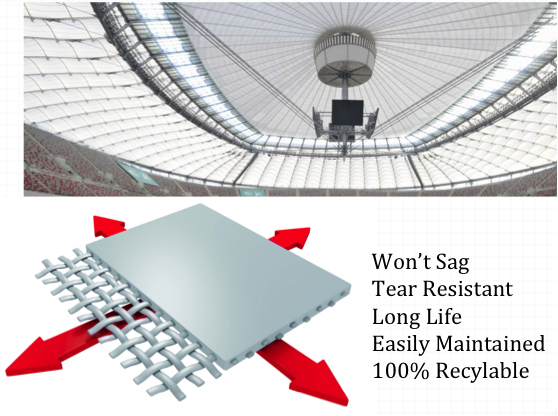
Controlling Solar Heat Gain – Selecting a fabric to control solar heat gain for an exterior shade is different then choosing one for an interior installation. Since darker colors absorb light, which turns into heat, we know that could be a problem for interiors as the graphic below shows.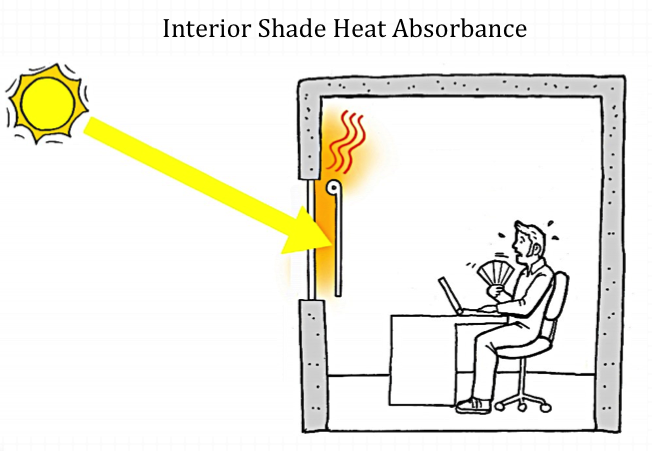
However, when the shade is installed on the exterior the heat absorbed by the darker fabric and is released into the atmosphere before it has a chance to penetrate through the glazing and into the space.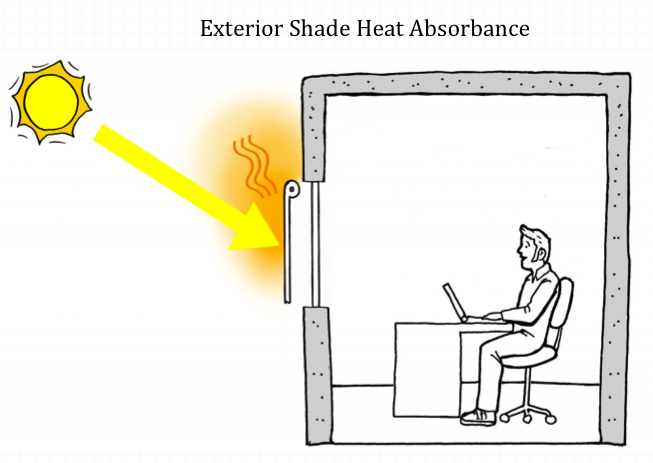
For this reason, darker colors perform better then lighter colors for exterior shades. The chart below offers some additional information.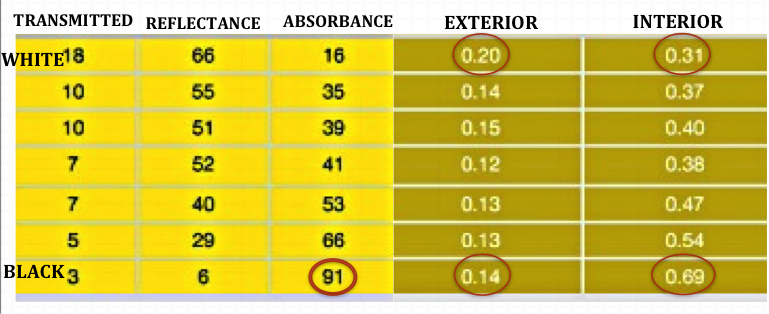
This solar heat gain (SHG) chart is for the Soltis 92 fabric from Serge Ferrari. It is comparing white vs. black fabric for an exterior and an interior application. The white color allows 31% SHG when used as an interior shade and drops to 20% for an exterior installation. The black color however allows 69% SHG on the interior but jumps to an amazing 14% performance once mounted on the exterior. This is due to the 91% absorbance, which dissipates into the atmosphere.
Visual Transmittance – Selecting an openness alone based on orientation may lead to disappointment. The color of the fabric plays a role in the amount of light entering a room. This is called visual transmittance. To compare, take the neile fabric with the neile openness, one in white and one in black. The white color brightens the room more then the black, because the darker colors will absorb more of the light. Therefore, choosing a fabric based on openness alone may not provide the desired solution.
Glare Control – Glare is caused by a significant ratio of luminance between the visual task and the glare source. A solar shade will reduce the disparity in light levels as in between a computer screen and a window.
To understand the cause of glare, let’s take a look at the 1-3-10 Luminance Ratio Rule. This means that the light level between the visual task and an adjacent surface needs to be less then 1 to 3. The light level between a visual task and a non-adjacent surface should fall within a 1 to 10 ratio.
In the photo below, the room without an Interior Shading Solution, the light levels fall way beyond the 1-3-10 Rule with the result being glare. However, with glare reducing fabrics, the levels are corrected and the glare is reduced by as much as 95%.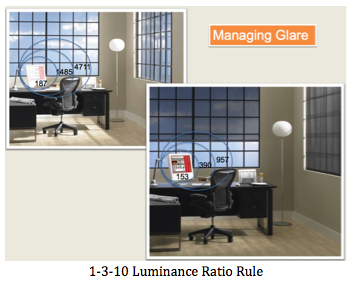 Let’s compare the neile fabric in the neile colors as our previous example on solar heat gain control. A white color 5% open fabric will reduce glare by 57%, while a black color fabric reduces glare by 90%. So clearly, the darker color has a significant advantage on reducing glare then light colors, since the darker color absorbs the light.
Let’s compare the neile fabric in the neile colors as our previous example on solar heat gain control. A white color 5% open fabric will reduce glare by 57%, while a black color fabric reduces glare by 90%. So clearly, the darker color has a significant advantage on reducing glare then light colors, since the darker color absorbs the light.
Transparency – One of the benefits of solar shade fabrics is the transparency or the ability to see through the fabric itself. Of course, this transparency is regulated by the openness, but it is also determined by the color. In the picture below, the top row is white color fabric in a series of openness of 1, 3, 5 and 10%. The bottom row is the neile arrangement of openness. Clearly the black color provides better transparency then the white color.
The ability to see through the fabric is an advantage of solar shade fabrics. It is important to remember, that there is a trade off between seeing through the fabric with a larger openness in exchange for allowing too much solar heat gain.
Finishes – Choosing an aluminum finish plays a role in shades, blinds and rolling shutters. On the Cable Guided, Tension Force and Zip Shades the head-box, cassette, side channels and hem-bar are aluminum and are available in standard colors. However, custom finishes are available. The RAL color matching system is the industry standard for identifying precise colors.
